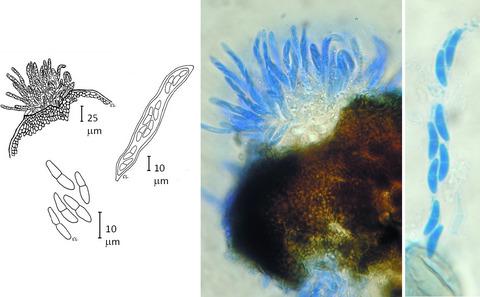当前位置:
X-MOL 学术
›
Plant Pathol.
›
论文详情
Our official English website, www.x-mol.net, welcomes your
feedback! (Note: you will need to create a separate account there.)
First report of the sexual stage of the flax pathogen Mycosphaerella linicola in France and its impact on pasmo epidemiology
Plant Pathology ( IF 2.3 ) Pub Date : 2020-10-15 , DOI: 10.1111/ppa.13296 Delphine Paumier 1 , Blandine Bammé 2 , Annette Penaud 2 , Romain Valade 1 , Frédéric Suffert 3
Plant Pathology ( IF 2.3 ) Pub Date : 2020-10-15 , DOI: 10.1111/ppa.13296 Delphine Paumier 1 , Blandine Bammé 2 , Annette Penaud 2 , Romain Valade 1 , Frédéric Suffert 3
Affiliation

|
We performed a 3‐year field survey in France to characterize the dynamics of sexual reproduction in Mycosphaerella linicola, the causal agent of pasmo, during the interepidemic period. Cohorts of fruiting bodies were sampled from linseed straw during the autumn and winter and carefully observed, focusing on pseudothecia, asci, and ascospores. A sequence of experimental steps corresponding to Koch's postulates confirmed in July 2014, for the first time in France and continental Europe, the widespread presence of the sexual stage of M. linicola in plant host tissues. The developmental dynamics of pseudothecia on straw, expressed as the change over time in the percentage of mature pseudothecia, was similar in all three years. Pseudothecia appeared in late summer, with peak maturity reached in October. A temporal shift, thought to be due to early autumn rainfall, was highlighted in one of the three years. These observations suggest that sexual reproduction plays a significant role in the epidemiology of pasmo in France. A resurgence of M. linicola infections in spring flax is thought to have occurred in recent years, due to the increase in the area under flax. The presence of the sexual stage of this pathogen probably increased the quantitative impact of residues of winter linseed (used for oil) and flax straw (left on the soil for retting and used for fibres) as an interepidemic “brown bridge”. This case study highlights how certain parts of a disease cycle, in this case the sexual phase, can become crucial due to changes in production conditions.
中文翻译:

法国亚麻病原菌Mycosphaerella linicola有性阶段的第一份报告及其对女性流行病学的影响
我们在法国进行了为期三年的实地调查,以研究在流行病间隔期间,巴斯克病的致病因子Mycosphaerella linicola有性繁殖的动态。在秋季和冬季,从亚麻籽秸秆中取样子实体的队列,并仔细观察,重点放在假pseudo草,子囊和子囊孢子上。与科赫的假设相对应的一系列实验步骤于2014年7月得到确认,这是法国和欧洲大陆首次广泛存在M的性阶段。利尼科拉在植物宿主组织中。在稻草中假the虫的发育动力学,以成熟假the虫的百分比随时间的变化表示,在这三年中都相似。假性皮病在夏末出现,十月达到成熟高峰。在这三年中,有一个时间偏移被认为是秋季初雨造成的。这些观察结果表明,在法国,有性生殖在女性流行病学中起着重要作用。M的复活。利尼科拉由于亚麻下面积的增加,人们认为春季亚麻感染是近年来发生的。该病原体有性阶段的存在可能增加了冬季亚麻籽(用于油)和亚麻秸秆(留在土壤上用于纤维化并用作纤维)的残留物的定量影响,这是一个流行间的“棕色桥”。该案例研究强调了疾病周期的某些部分(在这种情况下为性阶段)如何因生产条件的变化而变得至关重要。
更新日期:2020-10-15
中文翻译:

法国亚麻病原菌Mycosphaerella linicola有性阶段的第一份报告及其对女性流行病学的影响
我们在法国进行了为期三年的实地调查,以研究在流行病间隔期间,巴斯克病的致病因子Mycosphaerella linicola有性繁殖的动态。在秋季和冬季,从亚麻籽秸秆中取样子实体的队列,并仔细观察,重点放在假pseudo草,子囊和子囊孢子上。与科赫的假设相对应的一系列实验步骤于2014年7月得到确认,这是法国和欧洲大陆首次广泛存在M的性阶段。利尼科拉在植物宿主组织中。在稻草中假the虫的发育动力学,以成熟假the虫的百分比随时间的变化表示,在这三年中都相似。假性皮病在夏末出现,十月达到成熟高峰。在这三年中,有一个时间偏移被认为是秋季初雨造成的。这些观察结果表明,在法国,有性生殖在女性流行病学中起着重要作用。M的复活。利尼科拉由于亚麻下面积的增加,人们认为春季亚麻感染是近年来发生的。该病原体有性阶段的存在可能增加了冬季亚麻籽(用于油)和亚麻秸秆(留在土壤上用于纤维化并用作纤维)的残留物的定量影响,这是一个流行间的“棕色桥”。该案例研究强调了疾病周期的某些部分(在这种情况下为性阶段)如何因生产条件的变化而变得至关重要。











































 京公网安备 11010802027423号
京公网安备 11010802027423号